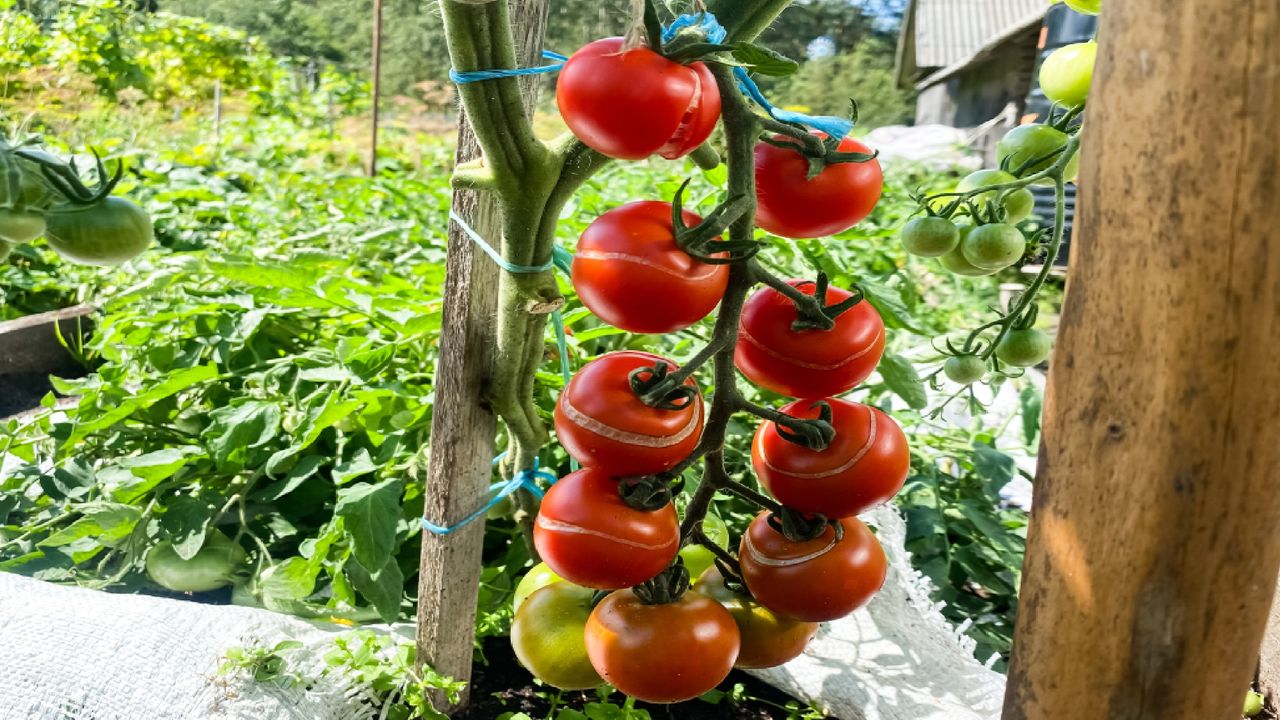Lifestyle
Quick Tips to Rescue Split Tomatoes and Ensure a Healthy Harvest

Tomato growers often face the frustration of seeing their prized fruits develop unsightly cracks just as they reach peak ripeness. Split tomatoes, while visually unappealing, can still be safe to eat if action is taken swiftly. Understanding the causes of tomato splitting and learning how to prevent it can help gardeners salvage their crops and maintain a bountiful harvest.
Understanding the Causes of Tomato Splitting
Many gardeners mistakenly believe that tomatoes split due to overripeness. In reality, the primary cause is inconsistent watering. When soil moisture levels fluctuate—such as during periods of drought followed by heavy rain or excessive watering—tomatoes absorb water faster than their skins can stretch. This rapid absorption leads to swelling, resulting in cracks forming from the inside out. Such splits are particularly common during hot, dry spells that are followed by thunderstorms.
Excess nitrogen in the soil can also accelerate growth, increasing the likelihood of splitting. Additionally, allowing tomatoes to overripen on the vine can make them more susceptible to cracking due to reduced flexibility in the skin.
Identifying Early Warning Signs
Gardeners can take proactive measures by watching for early warning signs of splitting. Small cracks around the stem area often appear before full splits develop. If these hairline fractures are noticed, it is advisable to harvest the affected tomatoes immediately and allow them to finish ripening indoors.
Regularly checking the weather forecast during the growing season is crucial. Heavy rain following a dry spell can trigger splits, so harvesting tomatoes that are beginning to change color before storms arrive is a wise strategy. Furthermore, if the soil has completely dried out, the next batch of tomatoes is at a higher risk of splitting. Rapid growth in leaves and vines may indicate excess nitrogen, which can lead to splitting problems.
Salvaging Split Tomatoes
If split tomatoes are caught early, they can often still be consumed safely. Gardeners should cut away the split sections and inspect the remaining fruit for any signs of mold or an off smell. If the tomato appears healthy aside from the crack, it is safe to use. Split tomatoes are best used immediately rather than stored, as the exposed flesh is more vulnerable to bacteria and pests. They can be transformed into sauces, soups, or other dishes where appearance is less critical. It is essential to discard any split tomatoes that show signs of spoilage, including unusual smells or mushy textures, as these can harbor harmful bacteria.
Watering Techniques to Prevent Splitting
To minimize the risk of future splitting, consistent watering practices are essential. Aim to water tomato plants every three to four days, providing approximately 1-2 inches of water per week during the fruiting stage. Maintaining a regular watering schedule is more effective than allowing the soil to dry out and then soaking it. Keeping the top 2-3 inches of soil moist, without making it soggy, helps to regulate moisture levels.
Applying mulch around the plants can also aid in moisture retention and temperature regulation, preventing the extreme wet-dry cycles that lead to splitting. In anticipation of heavy rain after a dry period, consider covering plants temporarily or harvesting earlier to avoid sudden water shocks.
Selecting Crack-Resistant Tomato Varieties
For future planting, choosing tomato varieties bred for crack resistance can significantly reduce the likelihood of splitting. Notable crack-resistant varieties include Big Beef, Big Boy, and Box Car Willie, which are specifically developed to withstand fluctuations in water levels better than traditional varieties. Seed packets and plant labels typically indicate crack-resistant properties, making it easier for gardeners to select suitable options.
While no variety is completely immune to splitting, these options tend to be more forgiving of inconsistent weather conditions. Growing a mix of crack-resistant and traditional varieties can provide backup choices if adverse weather affects the growing season.
By employing these strategies, gardeners can rescue split tomatoes and ensure a healthy harvest, transforming potential losses into productive outcomes.
-

 Technology5 months ago
Technology5 months agoDiscover the Top 10 Calorie Counting Apps of 2025
-

 Health3 months ago
Health3 months agoBella Hadid Shares Health Update After Treatment for Lyme Disease
-

 Technology1 week ago
Technology1 week agoOpenAI to Implement Age Verification for ChatGPT by December 2025
-

 Health3 months ago
Health3 months agoErin Bates Shares Recovery Update Following Sepsis Complications
-

 Technology4 months ago
Technology4 months agoDiscover How to Reverse Image Search Using ChatGPT Effortlessly
-

 Technology3 months ago
Technology3 months agoElectric Moto Influencer Surronster Arrested in Tijuana
-

 Technology1 month ago
Technology1 month agoDiscover 2025’s Top GPUs for Exceptional 4K Gaming Performance
-

 Technology5 months ago
Technology5 months agoMeta Initiates $60B AI Data Center Expansion, Starting in Ohio
-

 Health3 months ago
Health3 months agoAnalysts Project Stronger Growth for Apple’s iPhone 17 Lineup
-

 Technology5 months ago
Technology5 months agoRecovering a Suspended TikTok Account: A Step-by-Step Guide
-

 Health5 months ago
Health5 months agoTested: Rab Firewall Mountain Jacket Survives Harsh Conditions
-

 Lifestyle5 months ago
Lifestyle5 months agoBelton Family Reunites After Daughter Survives Hill Country Floods











